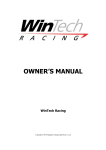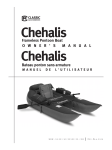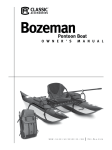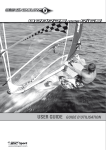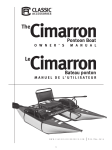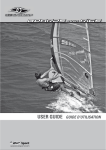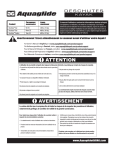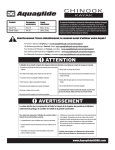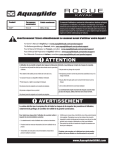Download Owners Manual - Hudson Boat Works
Transcript
Owners Manual 1930 Mallard Rd. London, Ontario, Canada N6H 5M1 519-473-9864 www.hudsonboatworks.com CONTENTS INTRODUCTION INSURANCE & TRANSPORTATION INSURANCE TRANSPORTATION CAR TOP TRAILERING ASSEMBLY TOOLS PARTS FOOT ASSEMBLY (WITHOUT SHOES AND SHOE PLATE) SEAT ASSEMBLY SLIDES RIGGER (SWEEP) RIGGING FEET RIGGER RIGGER SPREAD (SCULLING) SPAN (SWEEP) HEIGHT PITCH BACKSTAY (SWEEP) SLIDES STEERING (2-/4-X) CLEANING PROTECTION LUBRICATION SALT WATER ROWING STORAGE FAQ’S - RIGGER DIMENSIONS SWEEP SCULLING FAQ’S – CHANGING WHEELS/BEARINGS FAQ’S – REPLACING THE NEW FIN FAQ’S – HOW TO LIFT AND CARRY THE BOATS 2 3 4 4 4 5 6 7 7 8 8 9 10 11 12 12 15 15 17 17 19 21 22 23 24 26 26 27 27 28 29 29 30 31 32 34 INTRODUCTION Thank you for choosing Hudson. Your boat is a high performance racing machine, and taking the time to rig it properly will help you get the most out of it. With minimal preventative maintenance, your Hudson will give you years of trouble free pleasure. We have designed this owners manual to cater to all levels, and there are probably one or two things specific to Hudson Boats that even the most experienced coaches can learn (these are highlighted as tips). ORIGINAL MANUFACTURING DIMENSIONS AND CODES 3 INSURANCE & TRANSPORTATION We have chosen to make this the first thing you read, because chances are that before you rig (assemble) or wash your boat, you will have to move it. Your boat represents a large investment that can be damaged in transport, on water, and even on the rack. Please refer to the FAQ How to lift and carry the boat, as the 4-/x/+’s and 8+’s should be lifted by the rigger, or by the sides of the boat, and not the inspection port. INSURANCE Upon delivery your boat becomes your responsibility, and we recommend that you initiate insurance from the delivery date. Please consult with a broker to find the best coverage for you. Make sure that it is very clear that what you are insuring is a rowing shell, and that the broker understands everything that entails. If your broker has no solutions, you may want to ask other members at your club how they insure their boat. For our U.S. customers we recommend: Leonard Insurance Group 1-800-sculler (US only) 610-789-9600 Email: [email protected] For our Ontario customers we recommend: Petek Insurance Inc. Lisa Jeffries 1-877-738-3512 TRANSPORTATION There are two ways to transport your boat; on top of your car, or on a boat trailer. Before we discuss that, there are a few things you need to do to prepare the boat: • • • • • For the majority of transportation applications the rigger will be removed from the boat. We recommend that the nuts & bolts stay on the boat to prevent the bolts from scratching other riggers in transport. To ensure long life of the Velcro on the shoes, fasten them before travel. You can use the provided bungee to fix the seat to the slides (see photo), or you can remove the seat altogether by sliding it to the stern of the slides and bumping the bow of the seat with the heel of your hand (this requires some care in the singles and the lightweight double to not damage the paint). Check that all the slide wing nuts and the feet wing nuts are tight to prevent them from falling out and possibly causing damage to other boats. 4 Please note: When packaging a rigger with a backstay for transportation, we recommend that you loosen the top nut before you rotate the backstay. The port backstay will overtighten the top nut, and could cause damage when you rotate the backstay in line with the rigger arm. For all forms of transportation we highly recommend that you check that all ties downs and racks are secure before you depart. We also recommend that you check the tie downs and racks at every service stop, as changes in weather, and wind shear may affect the straps. We also recommend that you remove any tags from the straps. These tags can, and have abraded the paint over a trip. Car top Hudson builds racks for 1x’s and our 2-/x’s which are designed to attach to your cars roof rack (most factory racks will work, but we recommend aftermarket racks for more security). You can transport a single with the rigger mounted, just make sure that the rigger: cannot strike the car in high wind, will not interfere with the operation of your car doors, and does not protrude beyond the side of the car. With the hull upside down on the rack, put a strap around the boat and the rack ~4 inches from the sling. Ensuring that the webbing is flat all the way around, feed the end through the cam and draw the webbing through until the boat is secure. Then tie both sides of the strap together, by looping around the other side and creating a knot just below the cam. (see photos below) For longer trips, or if you are traveling through areas of high wind, we recommend you tie a safety rope over the boat to the tow mounts at the front of the car. This requires extreme care, The rope should be tied such that even if it does loosen it cannot get caught in the wheels of the car. If this happens and the rope is over the bow of the boat, the rope will snap the bow off. The safety rope should be tight enough to keep the boat from flying off the roof, but loose enough for the rack to take out the brunt of the road vibrations. The stern of the boat furthest from your back bumper should have a red flag attached to alert following drivers. State and Provincial Laws differ, so please consult you M.O.T. or D.O.T. for rules regarding car topping. 5 Trailering Trailers are the most common way to move crew and club boats. With a few precautions, you can make sure that your boat makes it to its destination safely (please note we are providing information to safely load your boats, refer to you automobile and trailer manufacturer for safe trailering); • • • • • • • Load boats to weight the tongue according to the directions of your trailer/tow vehicle. Check that any boats loaded on the trailer will not make contact with the tow vehicle in sharp turns, or dips in the road. Strap the boats down with cam straps (provided with your Hudson), with the cam ~ 2” above the gunnel, positioned such that it does not make contact with the hull. Thread the strap through the cam making sure the webbing lies flat against the hull, and draw on the end of the strap. Test the tightness by trying to move the boat side to side, if it moves draw on the end of the strap again. Once it is tight enough so the boat does not slide back and forth, tie the strap off against itself just below the cam. This will prevent the strap coming any looser should the cam fail. Thread the strap back under the rack, and cinch and knot the strap around itself a few times. For eights: Make sure there are three contact points, and make sure the contact points are level, if they are not use a shim to support the boat. Make sure to securely strap the boat at these three points. For Smaller Boats: Using two contact points, it is ideal if one of these points is the stern most rigger mounting pad. If the bow does not meet a trailer rack in the cockpit, use a bit of foam to protect the boat and tie it off on the bow deck, using caution to not overtighten on this end. 6 ASSEMBLY Hudson Boats are designed for simplicity and maximum flexibility in how you choose to set up your boat. TOOLS 7/16” wrench - Almost all of your adjustments can be performed using just one tool, the 7/16” wrench (11mm also works). This is the only tool you need to take your rigger off the boat and put it back on. Once you have rigged your boat to your specifications, this is the only tool you should have to carry for your boat. Tip: Using the box end (closed end) of the wrench lessens the risk of damage to the hull. The sharp edges of the open end can easily scratch, or damage the hull if it slips. The other safe option is to use a 7/16” nut driver. ¾” wrench - The only other wrench you’ll need for rigging is a ¾” (19mm will work) for adjusting the span or spread, and once you‘ve set it, you can forget it. Tip: While we use a 7/16” and ¾” wrench, the bolt shaft diameter determines the size. For example the bolt that threads into the top of the pin has a 7/16” hex head, but the shaft diameter is ¼” (the nut securing the base of the pin has a diameter of ½”). All of the 7/16” nuts and bolts for Hudson Boats have a thread pitch of 20, which means there are 20 threads per inch (the ½” nut at the base of the pin has a thread pitch of 13). The other dimension of the bolt is the length of the shaft, or in other words the total length without the head. So the proper designation for the bolt that threads in the top of the pin is: ¼” – 20 Hex Head Stainless Steel X 3/8”. Flathead Screwdriver or 5/16” (8mm will work) nut driver/wrench- If you have a sweep boat, you’ll have backstays, and will need a flathead screwdriver (but a dime will do the trick in a pinch) or a 5/16” (8mm will work) wrench to adjust the hose clamps. Tape Measure - For measuring heights and span/spread you’ll need a tape measure. Whether you choose standard or metric, it makes sense to use a tape measure that measures only standard or metric (so that the lines show on both sides) for optimum accuracy. Box level - To measure feet and oarlock height accurately and to check lateral pitch, a 48’ box level serves a dual purpose. If you’re not interested in lateral pitch, a straight edge will do. Pitch Meter - The blocks that the pins sit in come out of the factory pitched at 0 degrees in both stern and lateral directions. The pitch meter comes in handy to double check that you’ve put the pitch bushings in the oarlock properly. Internal Snap Ring Pliers – You’ll only need these if you want to change the bearings out of your wheels. (See FAQ’s Changing Wheels and Bearings) 7 PARTS Please use this section to help identify the parts referred to in this manual. Foot assembly (without shoes and shoe Plate) Toe Bar Foot Stretcher End Piece 1” Stretcher Bolt (side), Flat Washer, Lock Washer and Wing ¼” x ½” Bolts (they thread in the back of the toe bar and shoe plate to maintain angle and height) Hairpin Plug Notched Channel (side) Channel Screws Hairpin 1 ½” Stretcher Bolt (centre), Curved Washer, Lock Washer and Wing Nut Notched Channel (Centre) 8 Seat Assembly Furk Axle Seat Top Wheel Bearing Flat Washer Snap Ring Bolt Lock Washer 9 Slides Slide End Underside of Slide Flat Washer Slide Bolt Wingnut Lock Washer Slide Bolt Removal Hole 10 Rigger (Sweep) Sweep Angle Mount ¼” x 3/8” Bolt ¼” Lock Washer Speed Washer ¼” Flat Washer 3/8” Backstay Washer Oarlock Sweep Pin Pitch Bushing Height Washer ½” Flat Washer ½” Lock Washer ½” Nut Pin Block Rigger Shoe Mount 11 RIGGING There are almost as many ways to rig for individuals as there are individuals. For that reason, we are showing you how to adjust your Hudson rather than giving you specific rigging numbers. We have also put these adjustments in the order that we think they should be done, to make your life easier. For example, it is harder, though not impossible, to rig the feet with the rigger mounted. It is also important that when you are taking measurements that you take them from consistent points from seat to seat. Feet The feet are probably the most overlooked when it comes to rigging, but rigging them properly can have a large impact on your comfort, and your ability to apply all of your power. There are three adjustments that can be made to the feet: Foot angle The foot angle, or rake, is the angle of the shoes from the keel. This angle can be adjusted by loosening the bolts on the stern side of the toe bar with a 7/16” wrench, and sliding the hairpin up for a steeper angle, or down for a shallower angle. Tip: If the hairpin is not sliding freely, try loosening off the bolts on the stern side of the shoe plate. Most rowers are very comfortable, and very effective in the range of 39 to 42 degrees from horizontal. Some pitch meters are equipped to measure this angle, or you can use an angle locator available at most home improvement stores. • • • • Using the wing nuts, secure the toe bar in matching notches of the channel on both sides. Measure the angle off the heel plate. Loosen the two ¼” bolts on the stern side of the toe bar with a 7/16” wrench. Slide the hairpin up (through the toe bar) to increase the angle, or down to decrease the angle. It is important that the hairpin is properly seated in the bottom of a hollowed out notch in the center channel (see photo). Tighten the centre channel wing nut. Measure again, and repeat steps if necessary. O.K. • • 12 NO Tip: Once you are happy with the angle, tighten the centre channel wing nut, but set the height before you tighten the toe bar bolts. Foot Height Foot height is measured from the seat top to the heel cup of the shoe. This is one way you can get a consistent feel from boat to boat. Please note that the seat sits above the gunnel in the 1x’s and the Lightweight 2x, and the measurement procedure will differ because in all other boats you can measure down from the gunnel to the seat. To measure and adjust foot height in any boat where the seat sits above the gunnel (all 1x’s and the Lightweight Women’s 2x): • • • • • • • • • Place a straight edge across the gunnels in line with the pins (or another consistent point). Measure from the top of the straight edge to a consistent point on the seat, and remember/record this number (see photo below left) Move the straight edge forward so that it sits directly over the heels of the shoes. Press the heels down, and measure from the top of the straight edge to the bottom of the heels, and remember/record this number. (see photo below right) Subtract the first number from the second to get your height. To adjust, loosen two ¼” bolts on the sternside of the foot plate, and slide the feet up the hairpin for less height or down the hairpin for more height. Finger tighten the bolts to keep the feet from sliding when you re-measure. Repeat measurement and adjustment until you find the proper height. Using a 7/16” wrench, tighten the foot plate bolts, and the toe bar bolts if you haven’t done so already. For all other boats (except the 1x’s and the Lightweight Women’s 2x): • • • • Place a straight edge across the gunnels in line with the pins (or another consistent point). Measure from the top of the straight edge to a consistent point on the seat, and remember/record this number. (see photo next page left) Move the straight edge forward so that it sits directly over the heels of the shoes. Press the heels down, and measure from the top of the straight edge to the bottom of the heels, and remember/record this number. (see photo next page right) 13 • • • • • Subtract the first number from the second to get your height. To adjust, loosen two ¼” bolts on the sternside of the foot plate, and slide the feet up the hairpin for less height or down the hairpin for more height. Finger tighten the bolts to keep the feet from sliding when you re-measure. Repeat measurement and adjustment until you find the proper height. Using a 7/16” wrench, tighten the foot plate bolts, and the toe bar bolts if you haven’t done so already. Tip: How much should you tighten these bolts? Finger-tighten them, and then another ¼ to 1/3 of a turn with a 7/16” wrench. Foot Position Foot position on the tracks (bow to stern) is best determined on water, unless you know the measurement from the line of work that is best for you. There are a number of ways to set your feet. A good starting point for sculling would be to set your feet so that at the finish there is about 20cm between the ends of your grips. For sweep a good starting point is to set the feet so that the end of the handle is in line with the outside of your body in the finish position. Make sure that the toe bar and the hairpin are properly seated, and then tighten the wing nuts. 14 Rigger Placement For a starting position, we recommend that the rigger gets mounted so that the pin (or the line of work if you prefer) lines up with the bulkhead. Once you line up one rigger, you can count the holes, and place the other riggers based on the holes (this will keep that stations evenly spaced). Moving the rigger to the bow will move the athlete’s weight to the bow (assuming you move the feet to match the movement in the rigger). The reverse happens moving the rigger to the stern. Most coaches will have a preference as to how the boat trims. We recommend that at speed the boat looks like it’s running level (similar depth in the bow deck and stern deck). Tip: Once you are happy with your rigger placement, you can use the provided anodizing plugs (black plugs in your spare parts bag) to mark the holes on either side of you rigger for easy location when you de-rig and rig again. Mounting To mount the rigger (sculling): • • • • • • Slide a ¼” bolt and flat washer through the stern most hole of the rigger. Line the rigger up so that the pin (or line of work) is inline with the bulkhead. Using a provided flat washer, lock washer and ¼” nut, (see photo next page top left) finger tighten the nut to affix the rigger. Slide the remaining three bolts with washers through. Finger tighten the remaining nuts. Using two 7/16” wrenches tighten the rigger down. Tip: Affixing the rigger with the stern most hole first holds the rigger in place while you thread the remaining bolts and nuts. To mount the rigger (sweep): • • • • • • Slide a ¼” bolt and flat washer through the stern most hole on the opposite side of the pin. Line the rigger up so that the pin (or line of work) is inline with the bulkhead. Using a flat washer, lock washer and ¼” nut, finger tighten the rigger. Slide the remaining three bolts with washers through. Finger tighten the remaining nuts. Using two 7/16” wrenches tighten the rigger down. 15 ¼” Washer ¼” Lock Washer ¼” Nut ¼” Bolt Tip: Using the box end (closed end) of the wrench lessens the risk of damage to the hull. The sharp edges of the open end can easily scratch, or damage the hull if it slips. The other option would be to use a 7/16” nut driver. 16 Spread (Sculling) All sculling boats are coming out of the factory with stickers marking the spread measurements. To adjust using the factory stickers: • • • • • Insert the pin in the pin block so the pin key sits in the slot (See photo next page top left). If you tend to rig on the wide side, have the keys facing in, and if you tend to rig on the narrow side have the keys face out. Use the provided ½” flat washer, ½” lock washer and the ½” nut and finger tighten the pin (See photo next page top right). Slide the pin in the block until the machine mark on the base of the pin lines up with the desired spread. Tighten the pin with a ¾” wrench, as tight as manually possible. Check that tightening did not move the pin. To adjust without the factory stickers: • • • • • • • • Insert the pin in the pin block so the pin key sits in the slot (See photo next page top left). If you tend to rig on the wide side, have the keys facing in, and if you tend to rig on the narrow side have the keys face out. Use the ½” flat washer, ½” lock washer and the ½” nut and finger tighten the pin (See photo next page top right). Measure from the machine mark on one pin to the machine mark on the other, and then adjust one pin until you have the desired spread. Measure from the opposite slide to the pin, do the same on the other side. Are they even? If not move the pin that’s father away from the centre in, and the pin that’s closer out. To make small precise adjustments, try tapping the base of the pin with the wrench. Measure again to see that they’re even. Measure from one pin to the other to make sure it’s still the spread you want. Tighten the pin with a ¾” wrench, as tight as manually possible. Check that tightening did not move the pin. Span (Sweep) To adjust the span in a sweep boat: Here’s how to set it: • • • • • • Insert the pin in the pin block so the pin key sits in the slot (See photo next page top left). If you tend to rig on the wide side, have the keys facing in, and if you tend to rig on the narrow side have the keys face out. Use the ½” flat washer, ½” lock washer and the ½” nut and finger tighten the pin. (See photo next page top right) Mount the pins in finger tight, and a ¼ turn with a ¾” wrench. Measure across the gunnel in line with the pin. Divide this number in two. Place this number on the tape on the gunnel in line with the pin (this effectively puts the end of the tape at the centerline of the boat). Measure straight out to the pin (not up and on an angle), and adjust. To make small 17 • • precise adjustments, try tapping the base of the pin with the wrench. Measure again to see that you’ve adjusted it properly. Tighten the pin with a ¾” wrench, as tight as manually possible. Check that tightening did not move the pin. Pin Key ½” Flat Washer ½” Lock Washer Pin ½” Nut Tip: You can get a lot of leverage by orienting the wrench on the bolt so that you can pull on the wrench with one hand, and pull in opposite direction with your other hand against the rigger. (See photo below) 18 Height There are a lot of variables to take into consideration to find your optimal height. Outboard and span/spread will affect the angle of approach of the oar. The seat sits above the gunnel in the 1x’s and the Lightweight 2x, so the measurement procedure will differ from the rest of the boats. To measure and adjust oarlock height in any boat where the seat sits above the gunnel (all 1x’s and the Lightweight Women’s 2x): • • • • • • Place a straight edge across the gunnels in line with the pins (or another consistent point). Measure from the top of the straight edge to a consistent point on the seat, and remember/record this number (see photo below left) Measure from the top of the straight edge straight up to a consistent point on the oarlock, remember/record this number. (see photo below right) Add the first number to the second to determine the height. Use the provided speed clips, and washers to set the desired height. Every sculling rigger has one cm difference built in for overlap. For all other boats (except the 1x’s and the Lightweight Women’s 2x): • • • • • • • place the straight edge across the gunnel in line with the pin (or another consistent point). Measure from the top of the straight edge to a consistent position on the seat, remember/record this number. (see photo next page left) Measure from the top of the straight edge straight up to a consistent point on the oarlock, remember/record this number. (see photo next page right) Add these two numbers together to determine the height. Use the provided speed clips, and washers to set the desired height. Every sculling rigger has one cm difference built in for overlap. Every sweep rigger is manufactured to match the other original riggers for each boat. 19 Tip: If you look closely at the yellow speed washer, you’ll notice one face is flat, and the other has a shoulder (ridge) on it. The shoulder is designed to fit around the washers and the pitch bushings. If you find the oarlock is hard to turn, check to see if two of these shoulders are sitting against each other. If they are, you can move the speed washer adjacent to a regular washer or bushing to free it up. If you find that an oarlock has a bit too much vertical play, then moving the speed washers so the shoulder sits against the flat of another speed washer will tighten it up a bit. If it is still loose you can have the shoulders facing each other. 20 Pitch Every standard rigger comes out of the factory at 0 degrees stern pitch, and 0 degrees lateral. Using pitch bushings (CII) you can set the pitch from 1 degree through 7 degrees. Every oarlock comes with 4 degrees inserted, which is usually a good place to start, unless you know what pitch you use. Most oar manufacturers will have a recommended pitch for their oars. Tip: You can use the pin to extract a tight fitting bushing. Slide the oarlock up the pin until the bottom of the top bushing clears the top of the pin. Press the top of the oarlock towards the stern with one hand and press down with the other. It’s effective, and a lot safer than stabbing at it or yourself with a screwdriver. (See photos below) 21 Backstay (Sweep) The backstay is generally the last part to be put on the boat. They are designed to add stability to the pin. We recommend that the backstay attaches at the sweep angle mount of the rigger to the bow of the pin. This does not apply to tandem rigging, in which case you should attach it in the hole just to the stern of the rigger shoe. To install the back stays: • • • • • • • Loosen the hose clamps and the backstay insert stop (see photo below left) Align the backstay holes with the pin and the stern most hole of the rigger to the bow. Align and mount the backstay on the shouldered pin. Finger tighten the ¼” top nut with ¼” flat washer, and ¼” lock washer. Tighten the shouldered ¼” bolt with a flat washer between the bolt and backstay, and a flat washer between the backstay and the rigger, and a ¼” flat washer, and ¼” lock washer under the ¼” nut to secure the rigger and the backstay. Rotate the backstay insert stop until it is flush with the main arm of the back stay, then tighten the hose clamps Tighten the top nut with enough force to flatten the lock washer. Backstay Insert Backstay Insert Stop Please note: Our backstays are angled for the boat they were built for. If the backstay does not lay flush where it meets the boat when the bolt the threads in the top of the pin is tightened, it has to be bent to fit. Otherwise you risk damaging the pin. Fine adjustments can be made to the end of the backstay using a bench vise. (see photo below) 22 Slides If you know the work through that best suits you, or you set the finish position off of the slides, then you will adjust them before you get on the water. However, if you set the finish position, and then set the slides this will have to wait until you are in the boat. Once the feet position has been established, slide to the catch and finish position. If you are hitting either end, you can loosen the four wing nuts under the deck to move the slides. Check that they are even by sliding the seat to one end and seeing that the wheels both touch the slide end at the same time. (see photo below) Tighten the wingnuts and you’re away. Tip: If you are in the habit of changing the slides on the water, you might find that the wingnuts are hard to loosen on land. If the person who last changed the slides was sitting on the seat while they changed it, this would probably be the case. With a little bit of weight on the slide right over the wingnut, you should be able to loosen it. 23 STEERING (2-/4-X) Our pairs and straight fours are equipped with steering controlled by rotating the right foot of the steering shoe assembly. Hudson boats come ready to be steered by the stroke or the bow. Additional seat options can easily be accommodated upon request. Each athlete will have a preference as to how the steering gets setup. The steering can easily be adjusted by loosening the 7/16” bolt on the back side, and moving the cables in the desired direction. If you have a convertible boat (both sweep and sculling riggers), you have the option of removing the rudder and cables when you rig the boat for sculling if you so choose. With each boat the steering mechanism should consist of: • • • • • • A rudder A Tiller Bar Two cables Four sleeves (the tubing the cables slide through) of varying length Eight Cable Termination Block (white nylon blocks) two of which are on the steering foot assembly A steering foot assembly The photo below shows the steering set up for stroke seat. In this configuration four of the eight Cable Termination Blocks are used. Stroke Cable Termination Blocks Bow Redirect Cable Termination Blocks 24 To move the steering from the stroke seat to the bow seat: • • • • • • • • Loosen the ¼” bolt on the back of the toe with a 7/16” wrench. Draw the cables out of the toe, cable termination blocks, and the sleeving. Use the two shortest sleeves to bridge from the stroke cable termination block to the bow redirect cable termination blocks (Please Note: The cable termination blocks are not symmetric. One side is bored out enough to house the sleeve, the other side is big enough for the cable to be routed through) Rout the cable through (see photo below) Move the stroke shoe assembly to the bow seat, and the bow shoe assembly to the stroke seat. Use the longer sleeving to bridge the starboard bow cable termination block to the steering foot assembly, and the shorter to bridge the port side. Rout the cable through the cable termination blocks, and the sleeving (Please note: Straight fours will have additional cable guides) Thread the cable through the toe and adjust the steering as needed (See photo below) 25 CLEANING Your hull has been painted with an automotive paint, and can be cared for as such. A weekly washing when you row on fresh water helps maintain the painted surface of the hull. It also helps identify any damage. We recommend using a car wash soap, as opposed to a dish soap. Dish soap will quickly strip any protective coating that may have been applied to the decks or hull. • • • • • • • • • • • • • • Start with the boat right side up. Remove the seats. Wet the boat, and spray off any debris. Fill half a bucket with water and the appropriate amount of soap. Dump a soft cloth or wash mitt in the bucket and clean a section of the boat, then shake it out in the bucket often to prevent scratching the surface. Rinse that area. Repeat this process until the top of the boat is clean. Use a separate cloth to focus on the slides. With the decks and cockpit clean, roll the boat over. Spray the cockpit out from underneath to allow everything to drain out. Clean the hull in sections as above. Rinse the hull, and spray the decks and cockpit to remove any remaining soap. Clean the wheels, and put the seat(s) back in the boat. Dry with a chamois of a micro fiber cloth. Tip: If you have a lot of hard water stains on the bow deck, try a solution of vinegar and distilled water. This should make quick work of the water spots For any tough stains a fine automotive rubbing compound will take care of most of them. PROTECTION For your decks, we recommend you use an automotive wax. This will help cut down on the hard water spots on the bow deck, and ease cleanup. Giving a recommendation for the hull is not as simple. There are arguments back and forth over waxing, so we will give you some of the most salient points in this debate, and let you make up your mind. Pro Waxing: • • • • Waxing prevents a lot of contaminants from sticking, which most likely makes a waxed hull faster than a naked hull with some bonded contaminants. Anything that does bond, will be much easier to clean and remove. Ultra violet rays destroy paint, and most waxes have a u.v. protectant to extend the life of your paint. Most waxes have a jetting effect, making colours appear deeper and richer, and a gloss effect, making the surface shine. Bottom line, your boat looks better. Con Waxing: 26 • • It is generally agreed that wax disturbs the boundary layer of the laminar flow. The same beading action you witness on the decks, is disruptive to the way the boat moves through the water. How much this slows you down, is not well known. Waxing takes time. In truth you’ll probably spend more time cleaning a naked hull of contaminants, than you would cleaning and waxing a hull. LUBRICATION The only part that requires lubrication on your boat are the wheel bearings, (they are sealed to keep the grease that protects the bearing from escaping). The bearings can be repacked in grease, but in general it is much easier to replace them. Tip: Using WD40 may have a short term benefit of stopping squeaks, and getting the bearings moving a bit better, but in the long run it degrades the grease and attracts dirt. SALT WATER ROWING It’s no secret that rowing on salt water can be incredibly hard on equipment, but many of us have no choice about the type of water we row on. We have taken great strides to ensure that your equipment stands up to the conditions, and with a bit of maintenance it will. While it would be ideal to strip the entire boat down, and wash each part individually after every row, it is entirely unrealistic. That’s why every piece of aluminium on the boat has been hard anodized, and every bit of steel is stainless. We do recommend washing the boat, or at least hosing it down after every practice. Rowing on salt water provides another challenge where these dissimilar metals meet. It’s a process called electrolysis, and has proven to degrade even anodized aluminium. We are constantly looking for better ways to protect your investment, and are running tests with new products on an ongoing basis. Our current recommendation to prevent or reduce the effect of electrolysis, is Boeshield t-9, developed by Boeing. If you have trouble finding it at a local retailer, please try: http://www.boeshieldcanada.com/OR10.php (Canada) http://www.boeshield.com/index.htm (U.S.) Applying Boeshield to the stainless fastener, where ever it meets hard anodized aluminum every three months will substantially increase the service life of you parts. The areas where stainless meets the anodized aluminum are the following: • • • • • Slide bolts - loosen the slide wing nuts and remove the slides, slide the bolts to the middle and remove them through the hole, clean the bolt and apply boeshield. Toe-bar, and height adjustment bolts (and steering bolt) - leaving the wing nuts fastened to maintain angle mark height, remove clean and apply. Bottom channel bolt - bolt and flat washer. Rigger bolts (backstay & top) - remove clean apply bolt and top flat washer. Bearings – remove and apply to: wheel bolt, bearing (both sides), flat washer (try to keep the boesheild off the plastic wheel). 27 STORAGE If you are fortunate enough to live in a warmer clime, and row 365 days a year this section does not apply to you. For the rest of us, there comes a time when the cold/ice makes it too unpleasant/impossible to row. We recommend that before storing your boat, you give it a thorough cleaning to identify any potential problem areas to be addressed over the winter. There’s nothing worse in the spring than waiting for your boat to be repaired while the world gets a jump on you. Areas to look at: • • • • • The hull: are there any dings or cracks that should be fixed before next season? The seat: are the wheels and bearings in good condition? Will they last another season? The shoes: does the Velcro still keep your feet in? Are there any tears? Are the shoes still firmly attached to the foot plate? Does the smell keep you from spending too much time at the catch? Parts: are there any washers or fasteners you’ve put off replacing because you didn’t have time? Oarlocks: is there excessive wear on the oarlock? Is there too much slop in the bushings? Once you’ve determined that the boat is not in need of repair, we recommend that you remove the rigger for winter storage. The storage facility need not have temperature control. If there is a pest problem, or if birds have made the rafters above your boat a home, we recommend that you cover the boat, and remove the shoes. It is also important to ensure that the boat is properly supported when in storage. Ideally at least one end of the cockpit is supported. (see photos below) O.K. X X 28 FAQ’S - RIGGER DIMENSIONS What are the dimensions for my rigger? How do I measure them? All riggers produced after 2002 have a stamping on them designating the dimension(s). SWEEP Sweep riggers have one number stamped on the sweep angle mount. This number is the height in centimeters from the foot to the top of the pin block (see stamping below left). The best way to measure the rigger off the boat is to find a level floor, press down in between the boat mounts, and measure from the floor up to the top of the pin block (see below right). The depth on sweep riggers is pretty standard. To measure use a straight edge that runs parallel to the cross piece of the rigger, or perpendicular to the centerline of the boat, and lines up with the bow side of the pin block. Measure from the rigger cross piece to the straight edge. (See photo below) This measurement is in inches. 29 SCULLING Sculling riggers have two numbers stamped on them which gives the height in centimeters from the foot to the top of the pin block, and the depth of the rigger from the rigger cross piece to an imaginary line between the bowsides of the pin blocks measured in inches (see stamping below left). The best way to measure the rigger off the boat is to find a level floor, press down inbetween the boat mounts, and measure from the floor up to the top of the starboard pin block(see below right). This measurement is in centimeters. To measure the depth of the rigger put the rigger upright on the pin blocks on a level floor, and measure from the cross piece to the floor. This measurement is in inches. 30 FAQ’S – CHANGING WHEELS/BEARINGS How do I change a worn out wheel or bearing? To swap out a wheel and bearing assembly is fairly straightforward. The only tool you need is a flathead screwdriver (and maybe a pair of vise grips to keep the axel from spinning if the bolt is a bit tight). Please note the order that the wheel, washer and lock washer are in (see photo below) Lock Washer Flat Washer To change a bearing of a wheel that you want to keep, you’ll need a pair of internal snap ring pliers. A 7/16” socket will help press the bearing out, and a ½” socket will help press the new one in without destroying the seal. Snap Ring Internal Snap Ring Pliers 31 FAQ’s – Replacing the new fin How do I replace the new fin? Our fins have always been designed to break away under impact. Our new fin/finbox system make the fin immediately replaceable, as they do not require silicone to keep them in place. Begin by clearing the fin slot of any old silicone (and the tab of the broken fin), and removing the set screw. Ensure that there was no other damage that might require attention before you replace the fin. When you are ready to insert the new fin begin by inserting the tabbed end (bow side) first, and slide the fin as far to the bow as it will go. 32 Then tip the stern end down into the slot, and slide the fin to the stern. This will lock the stern end of the fin in. Using the provided allen key, you can replace the set screw to keep the fin from sliding out. While if is not necessary (as the fin box is sealed), you can use silicone to streamline the area. 33 FAQ’s – How to lift and carry the boats How do I lift and carry the boats? 1x – On all singles there is a grap handle at the bulkhead, and an inspection port between the slides. Using these two points offer a secure way of lifting the 1x. Carrying the 1x is very much a personal preference. Some like to carry it on their head, and some like to cradle the boat in their shoulder. 2-/x – It is most common to lift and carry the 2-/x ~ 5 feet from the ends of the boat. Some prefer to have the side of the hull cradled on their arm or on their shoulder, and others rather have the deck flat on their shoulder. 4-/x/+, 8+ - We recommend that all boats bigger than the 2-/x, are lifted by the rigger or the sides of the boat, and not by the inspection port (see photos below). These boats are almost exclusively carried with each rower having the gunnel opposite their rigger on their shoulder. O.K. O.K. X 34 NO 1930 Mallard Rd. London, Ontario, Canada N6H 5M1 519-473-9864 www.hudsonboatworks.com 35 36




































